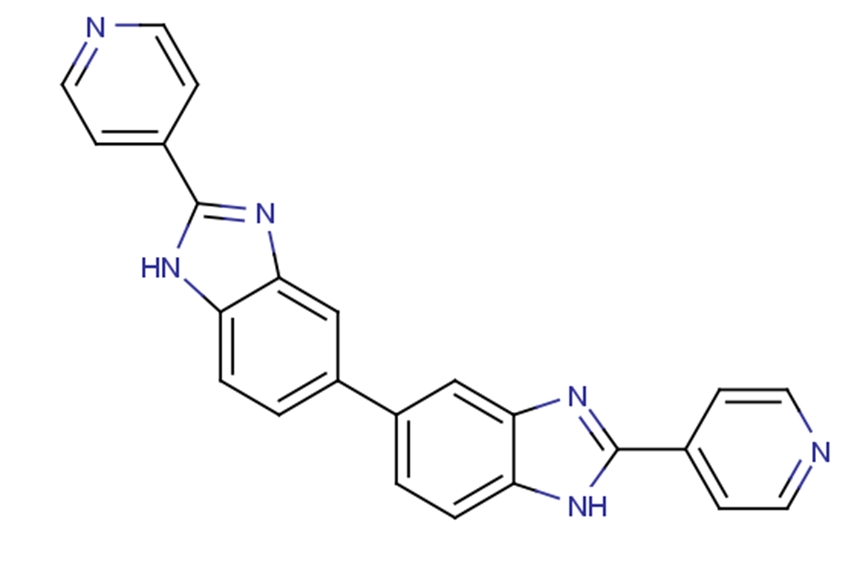
Ridinilazole
CAS No. 308362-25-6
Ridinilazole( SMT19969 )
Catalog No. M22106 CAS No. 308362-25-6
Ridinilazole is a novel narrow-spectrum nonabsorbable antibiotic.
Purity : >98% (HPLC)
 COA
COA
 Datasheet
Datasheet
 HNMR
HNMR
 HPLC
HPLC
 MSDS
MSDS
 Handing Instructions
Handing Instructions
| Size | Price / USD | Stock | Quantity |
| 2MG | 119 | In Stock |


|
| 5MG | 177 | In Stock |


|
| 10MG | 303 | In Stock |


|
| 25MG | 515 | In Stock |


|
| 50MG | 736 | In Stock |


|
| 100MG | 1017 | In Stock |


|
| 200MG | Get Quote | In Stock |


|
| 500MG | Get Quote | In Stock |


|
| 1G | Get Quote | In Stock |


|
Biological Information
-
Product NameRidinilazole
-
NoteResearch use only, not for human use.
-
Brief DescriptionRidinilazole is a novel narrow-spectrum nonabsorbable antibiotic.
-
DescriptionRidinilazole is a novel narrow-spectrum nonabsorbable antibiotic. Ridinilazole showed potent inhibition of C. difficile (MIC90=0.125 mg/L) and was markedly more active than either metronidazole (MIC90 = 8 mg/L) or vancomycin (MIC90 = 2 mg/L).ridinilazole , a novel antibacterial currently under development for the treatment of CDI. Owing to its highly targeted spectrum of activity and ability to spare the normal gut microbiota, ridinilazole provides significant advantages over metronidazole and vancomycin, the mainstay antibiotics for CDI. Ridinilazole is bactericidal against C. difficile and exhibits a prolonged post-antibiotic effect. Furthermore, treatment with ridinilazole results in decreased toxin production.(In Vitro):Ridinilazole is a novel antibacterial that does not appear to act through the classical pathways associated with antibiotics, such as inhibition of cell wall, protein, lipid, RNA or DNA synthesis. Ridinilazole may impair cell division. Ridinilazole is bactericidal against C. difficile and exhibits a prolonged post-antibiotic effect. In susceptibility testing of 82 clinical isolates of C. difficile (including ribotype 027), Ridinilazole displays potent growth inhibition and has lower MICs [MIC range, 0.06-0.25 μg/mL; MIC for 90% of the organisms (MIC90), 0.125 μg/mL] than Metronidazole (MIC range, 0.125-8 μg/mL; MIC90, 8 μg/mL) or Vancomycin (MIC range, 0.5-4 μg/mL; MIC90, 2 μg/mL). Similarly, Ridinilazole is found to be more potent than Metronidazole or Vancomycin at inhibiting the growth of 50 ribotype-defined C. difficile strains. The activity of Ridinilazole against specific C. difficile ribotypes (including ribotypes 001, 002, 005, 014, 027, 054 and 106) is similar, with an MIC range of 0.06–0.5 μg/mL and an MIC90 of 0.125 μg/mL. In addition, Ridinilazole is more active against 11 ribotype 027 strains than either Metronidazole or Vancomycin.(In Vivo):In a hamster model of CDI with a once-daily dosing regimen, Ridinilazole displays greater efficacy than Vancomycin both against non-epidemic and epidemic strains of C. difficile. Similar to the twice-daily dosing study, plasma levels of Ridinilazole are below the level of detection, whereas caecal Ridinilazole concentrations are well above the MIC, thus demonstrating the non-absorbable nature of Ridinilazole and minimal systemic exposure.
-
In VitroRidinilazole is a novel antibacterial that does not appear to act through the classical pathways associated with antibiotics, such as inhibition of cell wall, protein, lipid, RNA or DNA synthesis. Ridinilazole may impair cell division. Ridinilazole is bactericidal against C.?difficile and exhibits a prolonged post-antibiotic effect. In susceptibility testing of 82 clinical isolates of C.?difficile (including ribotype 027), Ridinilazole displays potent growth inhibition and has lower MICs [MIC range, 0.06-0.25?μg/mL; MIC for 90% of the organisms (MIC90), 0.125?μg/mL] than Metronidazole (MIC range, 0.125-8?μg/mL; MIC90, 8?μg/mL) or Vancomycin (MIC range, 0.5-4?μg/mL; MIC90, 2?μg/mL). Similarly, Ridinilazole is found to be more potent than Metronidazole or Vancomycin at inhibiting the growth of 50 ribotype-defined C.?difficile strains. The activity of Ridinilazole against specific C.?difficile ribotypes (including ribotypes 001, 002, 005, 014, 027, 054 and 106) is similar, with an MIC range of 0.06–0.5?μg/mL and an MIC90 of 0.125?μg/mL. In addition, Ridinilazole is more active against 11 ribotype 027 strains than either Metronidazole or Vancomycin.
-
In VivoIn a hamster model of CDI with a once-daily dosing regimen, Ridinilazole displays greater efficacy than Vancomycin both against non-epidemic and epidemic strains of C.?difficile. Similar to the twice-daily dosing study, plasma levels of Ridinilazole are below the level of detection, whereas caecal Ridinilazole concentrations are well above the MIC, thus demonstrating the non-absorbable nature of Ridinilazole and minimal systemic exposure.
-
SynonymsSMT19969
-
PathwayGPCR/G Protein
-
TargetAntibacterial
-
RecptorAntibacterial
-
Research AreaImmune system
-
IndicationClostridium Difficile Infection
Chemical Information
-
CAS Number308362-25-6
-
Formula Weight388.42
-
Molecular FormulaC24H16N6
-
Purity>98% (HPLC)
-
SolubilityDMSO:55 mg/mL (141.6 mM)
-
SMILESc1cc(ccn1)-c1nc2cc(ccc2[nH]1)-c1ccc2[nH]c(nc2c1)-c1ccncc1
-
Chemical Name——
Shipping & Storage Information
-
Storage(-20℃)
-
ShippingWith Ice Pack
-
Stability≥ 2 years
Reference
1.Vickers RJ, et al. Ridinilazole: a novel therapy for Clostridium difficile infection. Int J Antimicrob Agents. 2016 Aug;48(2):137-43.
molnova catalog



related products
-
Pactamycin
Pactamycin (NSC 52947) is a potent protein synthesis inhibitor.
-
Ampicillin
Ampicillin is an orally active broad-spectrum antibiotic.
-
Captan
Captan (Aacaptan) is a phthalimide fungicide that disrupts oocyte development.Captan is cytotoxic to mammalian cells and enhances the cytotoxicity of hydrogen peroxide.



 Cart
Cart
 sales@molnova.com
sales@molnova.com


